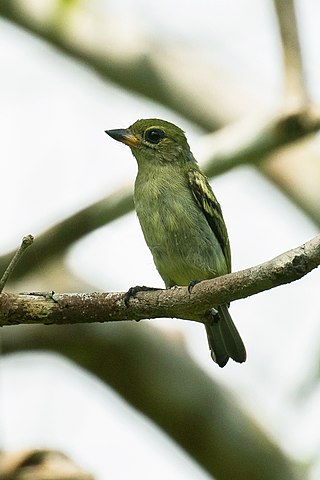Top Qs
Timeline
Chat
Perspective
Green tinkerbird
Species of bird From Wikipedia, the free encyclopedia
Remove ads
The green tinkerbird (Pogoniulus simplex) is a species of bird in the African barbet family Lybiidae. It is found in East Africa (Kenya, Malawi, Mozambique, and Tanzania).
Remove ads
Taxonomy and etymology
The genus name Pogoniulus is a diminutive of the name Pogonias that had been introduced in 1811 by Johann Karl Wilhelm Illiger.[2] Pogonias is from the Ancient Greek πωγωνιας/pōgōnias meaning "bearded".[3] The specific simplex is from latin, meaning "simple", "plain".[4]
Alternative English names for this species include "Eastern Green Tinkerbird," "Green Tinker Barbet," and "African Green Tinkerbird." In historical literature, it has been previously referred to as the "Little Green Barbet."[5]
Remove ads
Description
The Green Tinkerbird is a diminutive (approximately 11.5 cm, 8.8 g) and active olive-green barbet characterized by a lack of obvious facial markings, a short, two-toned bill with a black tip and yellow base, a conspicuous bright yellow rump, and two distinct yellow wing bars. In the field, this species exhibits a predominantly olive-green appearance with a paler gray-olive underside. The short, dagger-shaped bill is a key feature, along with the striking yellow rump that is often puffed up during vocalizations.[6]
This species closely resembles the Moustached tinkerbird, however, their ranges overlap only slightly, and they can be distinguished by the Green Tinkerbird's lack of facial markings.[7]
It is typically detected by its vocalizations, which include accelerating trilled phrases that may be repeated for extended periods. It also produces a slower series of tooting notes.[7]
Remove ads
Ecology
Summarize
Perspective
Distribution
The geographical distribution of the Green Tinkerbird is discontinuous. It is found along the East African coastal plain, inhabiting the foothills of the Eastern Arc Mountains and the Great Rift Valley. This range extends from Kenya in the north to Mozambique in the south, with a westward occurrence in Malawi east of the Rift Valley. It also occurs in the island of Zanzibar.[6]
Habitat
It inhabits a variety of forest and thicket habitats across East Africa, ranging from coastal rag thickets at sea level to mid- and Afromontane forests up to 1,700 meters in elevation. It exhibits a preference for dense, tangled understories within these habitats, often found in secondary forests and degraded remnants. While generally forest-dependent, it may occasionally venture into adjacent open woodlands.[8]
Breeding
Very little is known about the species' breeding habits, as only two nests have been documented.[6] During a birding trip with Reach Africa Safaris on 3–4 March 2014 in the Boniane-Unguana area of Mozambique, 12 birders observed and photographed a Green Tinkerbird at what appeared to be its nest, marking only the third confirmed sighting of this species in southern Africa and the first documentation of its nesting behavior. The nest, located 1.6 meters off the ground in a dense thicket, was decorated with mistletoe fruit and seeds. The observation revealed that only one bird seemed to attend the nest, incubating for approximately 20 minutes before foraging. Upon returning, the bird made a distinct call, different from its usual vocalizations.[9]
Status
This species is evaluated as "Least Concern" on the IUCN Red List due to its large range, which does not meet the criteria for vulnerability based on range size. While the population trend appears to be decreasing, the decline is not considered rapid enough to warrant a vulnerable status. Although the population size is unknown, it is not believed to approach the thresholds for vulnerability.[10]
Remove ads
References
External links
Wikiwand - on
Seamless Wikipedia browsing. On steroids.
Remove ads


